Discover 35 hidden attractions, cool sights, and unusual things to do in Toledo (Spain). Don't miss out on these must-see attractions: Toledo Cathedral, Monastery of San Juan de los Reyes, and Museo de Santa Cruz. Also, be sure to include Synagogue of El Transito in your itinerary.
Below, you can find the list of the most amazing places you should visit in Toledo (Castilla-La Mancha).
Table of Contents
Toledo Cathedral

Also known as: Catedral de Toledo
Cathedral in Toledo, Spain. The Primatial Cathedral of Saint Mary of Toledo, otherwise known as Toledo Cathedral, is a Roman Catholic church in Toledo, Spain. It is the seat of the Metropolitan Archdiocese of Toledo.
The cathedral of Toledo is one of the three 13th-century High Gothic cathedrals in Spain and is considered, in the opinion of some authorities, to be the magnum opus of the Gothic style in Spain. It was begun in 1226 under the rule of Ferdinand III and the last Gothic contributions were made in the 15th century when, in 1493, the vaults of the central nave were finished during the time of the Catholic Monarchs. It was modeled after the Bourges Cathedral, although its five naves plan is a consequence of the constructors' intention to cover all of the sacred space of the former city mosque with the cathedral, and of the former sahn with the cloister. It also combines some characteristics of the Mudéjar style, mainly in the cloister, with the presence of multifoiled arches in the triforium. The spectacular incorporation of light and the structural achievements of the ambulatory vaults are some of its more remarkable aspects. It is built with white limestone from the quarries of Olihuelas, near Toledo.
It is popularly known as Dives Toletana (meaning The Rich Toledan in Latin).[1]
Address: C. Cardenal Cisneros, 1, 45002 Toledo
Monastery of San Juan de los Reyes
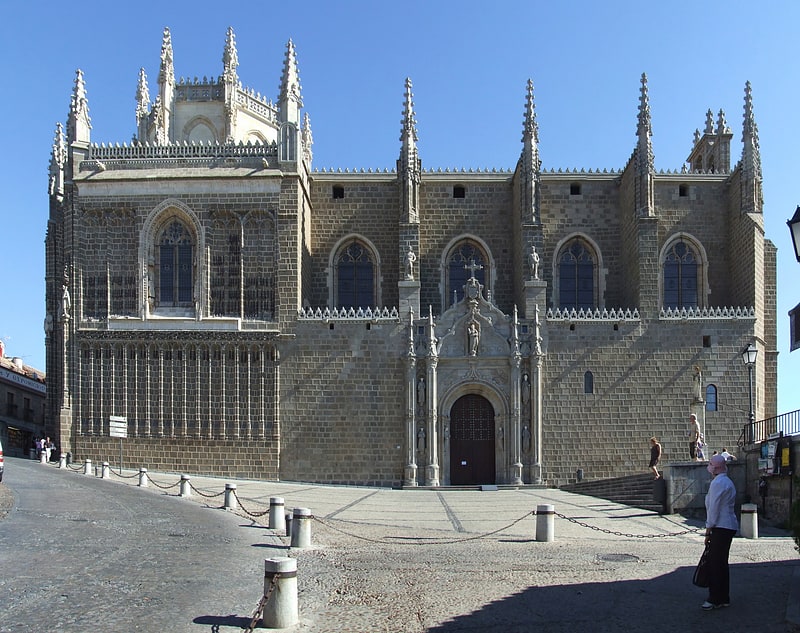
Also known as: Monasterio de San Juan de los Reyes
Monastery in Toledo, Spain. The Monastery of San Juan de los Reyes is an Isabelline style Franciscan monastery in Toledo, in Castile-La Mancha, Spain, built by the Catholic Monarchs.[2]
Address: Calle de los Reyes Católicos, 17, 45002 Toledo
Museo de Santa Cruz
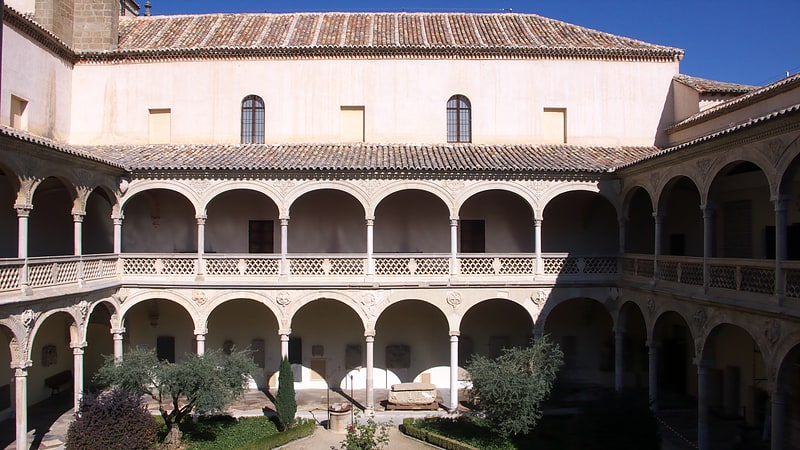
Museum in Toledo, Spain. The Museum of Santa Cruz is an art, archaeology and ethnographic museum located in the historic centre of the city of Toledo, Spain. It exhibits collections pertaining to the province of Toledo, including works painted by El Greco in the city of Toledo.
The museum is housed in an architecturally significant 16th-century building, the Hospital de Santa Cruz, which has been protected by a heritage designation, currently Bien de Interés Cultural, since 1902.
It is owned by the Spanish State and operated by the regional administration, the Junta de Comunidades de Castilla-La Mancha.[3]
Address: Calle Miguel de Cervantes, 3, 45001 Toledo
Synagogue of El Transito
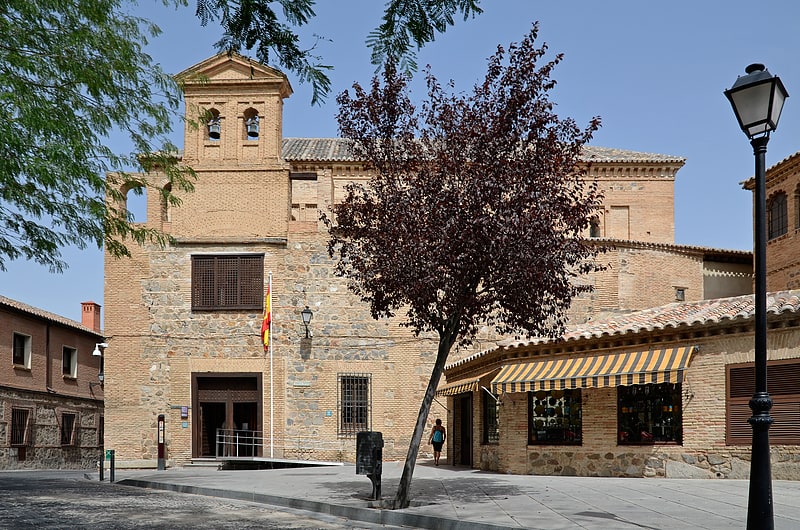
Also known as: Sinagoga del Tránsito
Building in Toledo, Spain. The Synagogue of El Tránsito, also known as the Synagogue of Samuel ha-Levi or Halevi, is a historic synagogue, church, and Sephardic museum in Toledo, Spain. It was built as an annex of the palace of Samuel ha-Levi Abulafia, treasurer to King Peter of Castile, in 1357. The synagogue was converted into a church after the expulsion of the Jews from Spain in 1492. It was briefly used as military barracks during the Napoleonic Wars of the early 1800s. It became a museum in 1910. Today it is formally known as the Sephardi Museum. The building is known for its rich stucco decoration, its Mudejar style, and its women's gallery.[4]
Address: Calle Samuel Levi S/N, 45002 Toledo
Santa María la Blanca

Museum in Toledo, Spain. The Synagogue of Santa María la Blanca is a museum and former synagogue in Toledo, Spain. Erected in 1180, according to an inscription on a beam, it is disputably considered the oldest synagogue building in Europe still standing. It is now owned and preserved by the Catholic Church.
The synagogue is located in the former Jewish quarter of the city, between the Monastery of San Juan de los Reyes and the Synagogue of El Transito. Its stylistic and cultural classification is unique among surviving buildings as it was constructed under the Christian Kingdom of Castile by Islamic architects for Jewish use. It is considered a symbol of the cooperation that existed among the three cultures that populated the Iberian Peninsula during the Middle Ages.[5]
Address: Calle de los Reyes Católicos, 4, 45002 Toledo
Puerta del Cambrón
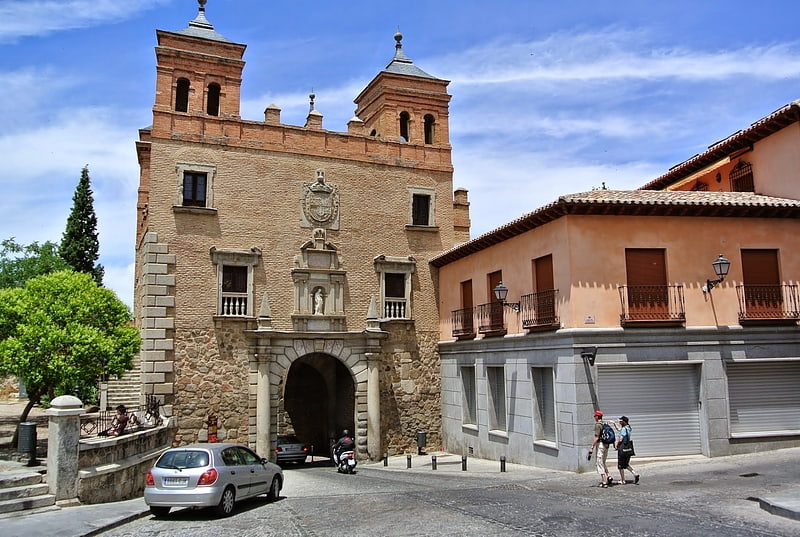
The Puerta del Cambrón is a gate located in the west sector of the Spanish city of Toledo, in Castile-La Mancha. Also called previously "Gate of the Jews" or "Gate of Saint Leocadia", has been speculated The possibility that the name of the gate, del Cambrón, had its origin in the growth of a thorn bush or plant at the top of the ruins of one of the towers, before the last reconstruction of the gate, In 1576. It has the cataloging of Bien de Interés Cultural.[6]
Address: Paseo de Recaredo, 45002 Toledo
Museum of the Army
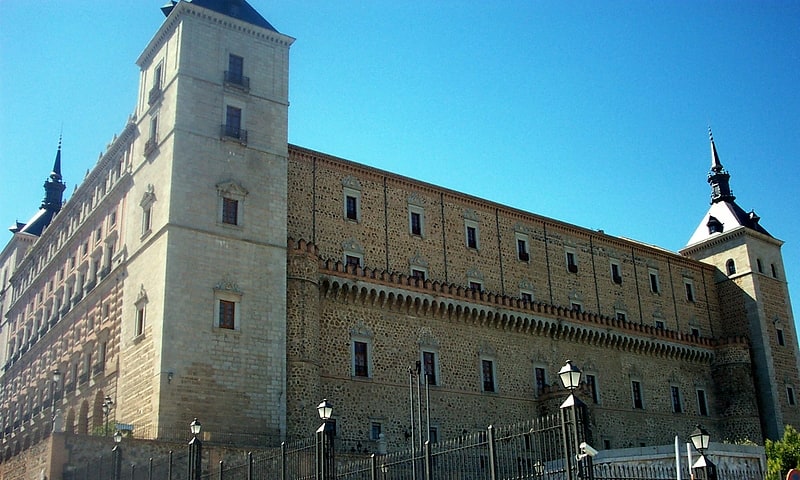
Also known as: Museo del Ejército
Museum in Toledo, Spain. The Museum of the Army is a national museum located in Toledo, Spain, attached to the Ministry of Defence.
The collection was previously housed in Madrid, and the museum opened on its present site in 2010. It occupies two linked buildings, Toledo's historic Alcázar (castle) and a purpose-built extension.[7]
Address: Calle de la Paz, s/n, 45001 Toledo
Church of San Idelfonso
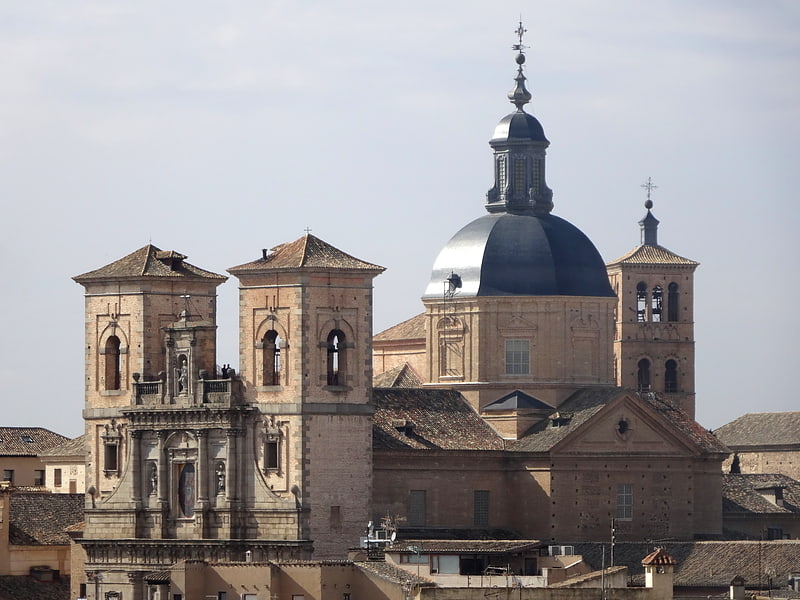
Also known as: Iglesia de San Ildefonso
Parish in Toledo, Spain. The Church of San Ildefonso is a Baroque style church located in the historic center of the city of Toledo, in Castile-La Mancha, Spain. It is also known as the Jesuit church and is consecrated to Saint Ildefonso of Toledo, patron of the city and Father of the Church.[8]
Address: Plaza Padre Juan de Mariana, 1, 45002 Toledo
Puente de Alcántara
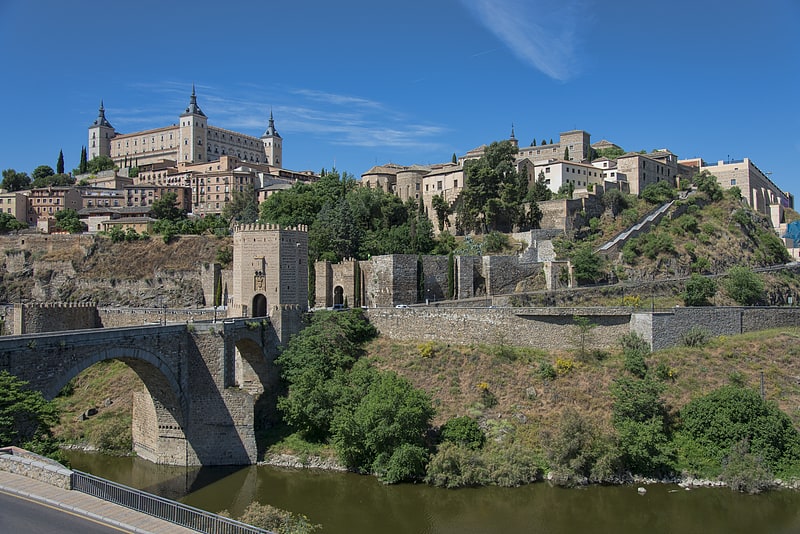
Bridge in Toledo, Spain. The Puente de Alcántara is a Roman arch bridge in Toledo, Spain, spanning the Tagus River. The word Alcántara comes from Arabic القنطرة, which means "arch".
Located at the foot of the Castillo de San Servando, it was built by the Romans after they founded the city. In the Middle Ages it was one of the few entrances for pilgrims into the city.
It currently has two arches. There is evidence of its construction in Roman times, at the founding of Toletum. It was damaged and rebuilt in the 10th century, at which time a third arch disappeared, reduced to a gate with a horseshoe arch. It was one of the only bridges that gave access to the city and in the Middle Ages it was the obligatory entry for all pilgrims.
During the reign of Alfonso X of Castile it suffered serious damage and was rebuilt. The western tower belongs to this period, later decorated under the reign of the Catholic Monarchs, whose arms decorate its walls. The fruit of the pomegranate (the emblem of Granada) is missing from them, because the Reconquista had not finished at that time.
The eastern tower was replaced by a Baroque triumphal arch in 1721, because of its ruinous state.
It was declared a national cultural monument in 1921.
The bridge should not be confused with either the Alcántara Bridge in Alcántara or the Alconétar Bridge in the Extremadura region, both Roman bridges are situated further downstream.[9]
Puente de San Martín

Arch bridge in Toledo, Spain. The Puente de San Martín is a medieval bridge across the river Tagus in Toledo, Spain.
The Puente de San Martín features five arches, with the largest in the middle having a span of 40 meters. Only very few bridges in the world were that long at the time of its construction.[10]
Address: Carretera de Piedrabuena, 2, 45004 Toledo
El Greco Museum

Also known as: Museo del Greco
Art museum in Toledo, Spain. The El Greco Museum is located in Toledo, Spain. It celebrates the mannerist painter El Greco, who spent much of his life in Toledo, having been born in Fodele, Crete.[11]
Address: Paseo Tránsito, s/n, 45002 Toledo
Castillo de San Servando
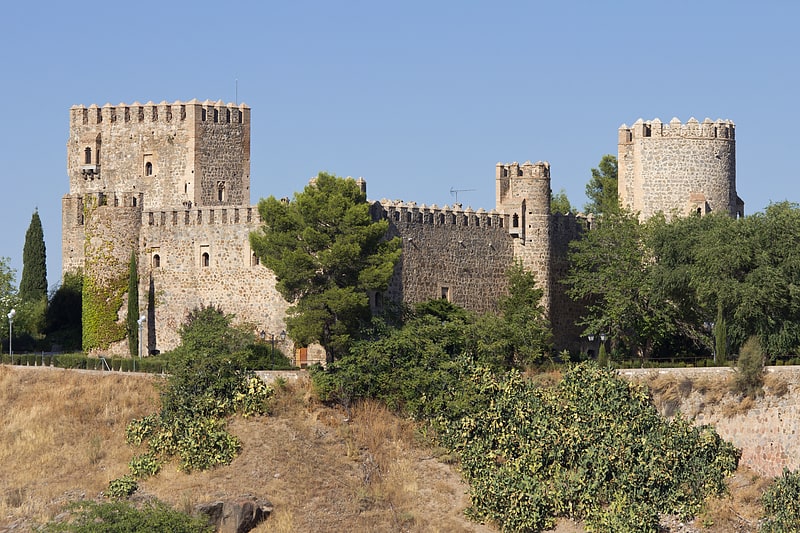
Medieval castle in Toledo, Spain. The Castle of San Servando is a medieval castle in Toledo, Spain, near the Tagus River. It was begun as a monastery, occupied first by monks and later by the Knights Templar.
In 1874 the castle was named a national monument. The fortress was depicted in El Greco's painting View of Toledo. Lying at the opposite bank of the Tagus than the main urban core, it is connected to the Santa Bárbara residential area through the Cuesta de San Servando.[12]
Address: Subida de San Servando, s/n, 45006 Toledo
Puerta de Bisagra Nueva
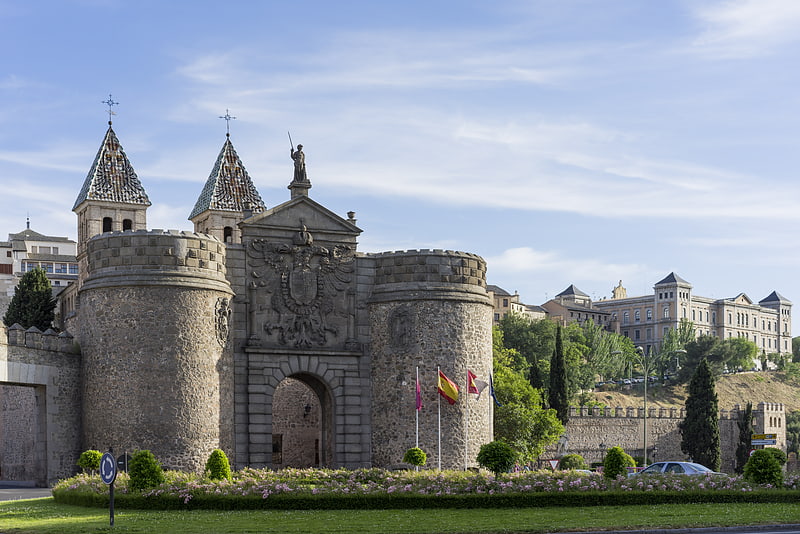
Also known as: Puerta Nueva de Bisagra
The Puerta de Bisagra Nueva is the best known city gate of Toledo, Spain.
The gate is of Moorish origin, but the main part was built in 1559 by Alonso de Covarrubias. It carries the coat of arms of the emperor Charles V. It superseded the Puerta Bisagra Antigua as the main entrance to the city.[13]
Address: 5 Callejón del Potro, Toledo
Hospital de Tavera

Archive in Toledo, Spain. The Hospital de Tavera, also known as the Hospital de San Juan Bautista, Hospital de afuera, or simply as Hospital Tavera, is an important Building of Renaissance style that is in the Spanish city of Toledo. It was built between 1541 and 1603 by order of the Cardinal Tavera. This hospital is dedicated to John the Baptist and also served as pantheon for its patron, Cardinal Tavera. Initially it began to be constructed under the supervision of Alonso de Covarrubias, being succeeded by other architects and finishing the work Bartolomé Bustamante.
The remoteness with the old part of the city made it known as el hospital de afuera, since within the walls there already existed the Hospital de Santa Cruz.
Currently the building remains the property of the House of Medinaceli and inside it is the Museo Fundación Lerma, which houses part of the artistic collections of this lineage, as well as the Section of the Nobility of the National Historic Archive.[14]
Address: Calle Duque de Lerma, 2, 45003 Toledo
Mosque of Cristo de la Luz

Also known as: Cristo de la Luz
Mosque in Toledo, Spain. The Mosque of Cristo de la Luz is a former mosque in Toledo, Spain. It is the one of the ten that existed in the city during the Moorish period. The edifice was then known as Mezquita Bab-al-Mardum, deriving its name from the city gate Bab al-Mardum. It is located near the Puerta del Sol, in an area of the city once called Medina where wealthy Muslims used to live.[15]
Address: Calle Cristo de la Luz, 22, 45002 Toledo
Sephardic Museum
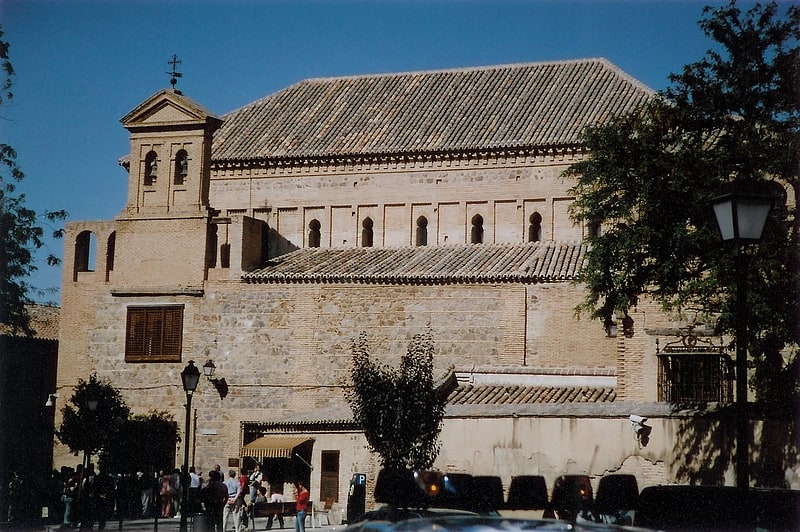
Also known as: Museo Sefardí
Museum in Toledo, Spain. The Sephardic Museum is a national museum in Toledo, Spain, that exhibits a collection of the Jewish cultural heritage in Spain, as well as of the Sephardim, the descendants of the Jews who lived on the Iberian peninsula until 1492. It occupies the former convent of the Knights of Calatrava, annexed to the Synagogue of El Tránsito.[16]
Address: Calle Samuel Levi, 2, 45002 Toledo
Church of San Román
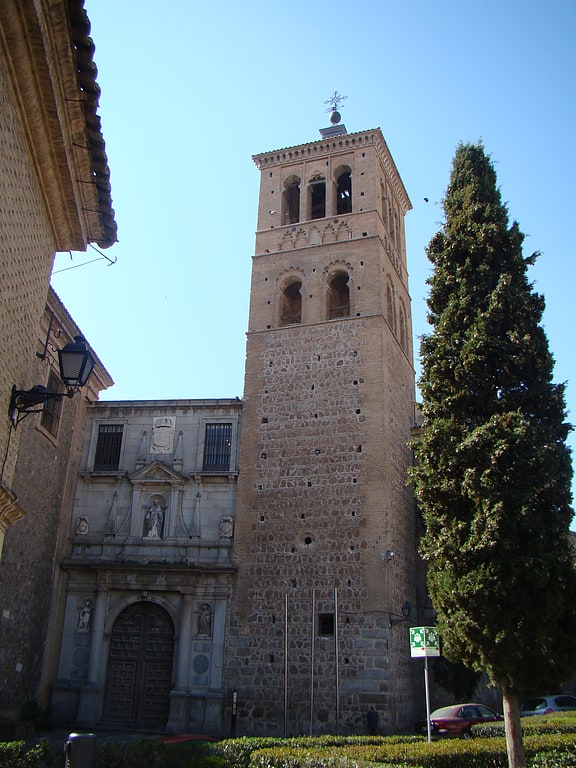
Also known as: Iglesia de San Román
Building in Toledo, Spain. The Iglesia de San Román is a church in Toledo. The church was built in the Mudéjar style in the 13th century. On this site there was an old Visigothic structure and probably an ancient Roman building.
The building is protected by a heritage listing. It currently houses a Visigothic museum, the "Museum of the Councils and Visigothic Culture" (the councils in question are the Councils of Toledo, the earliest of which assembled in 400).[17]
Address: Calle San Román, s/n, 45002 Toledo
Plaza de Zocodover
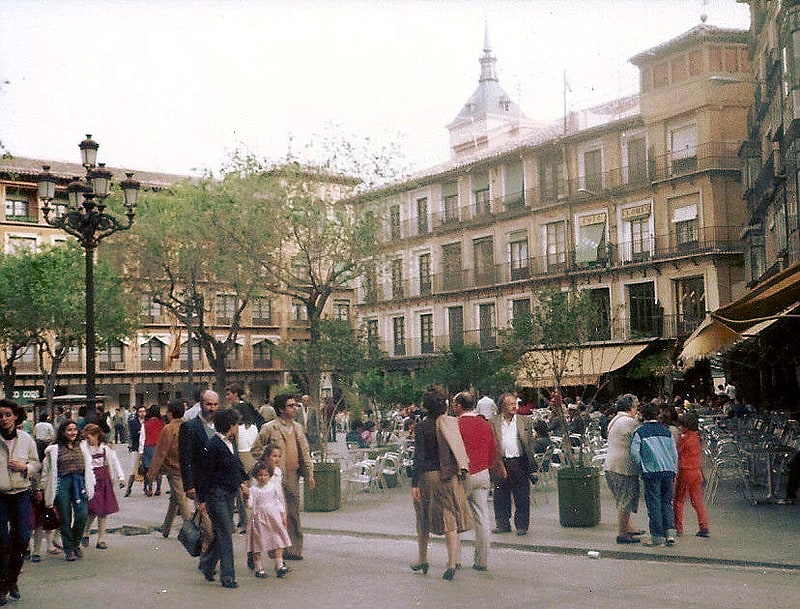
The Plaza de Zocodover is a square of the city of Toledo, in the autonomous community of Castile-La Mancha, Spain. It was the nerve center of the city during most of its history, acting as its main square. A part of it was designed by Juan de Herrera during the reign of Philip II.
Here horses, donkeys, foals, mares, mules and other beasts were sold, when the city of Toledo was Spanish-Muslim city.
Here the most important market of the city took place. It has been celebrated as a weekly market for centuries. Today it occurs on Tuesdays in the vicinity of Paseo de Merchán or de la Vega.[18]
Church of San Lucas
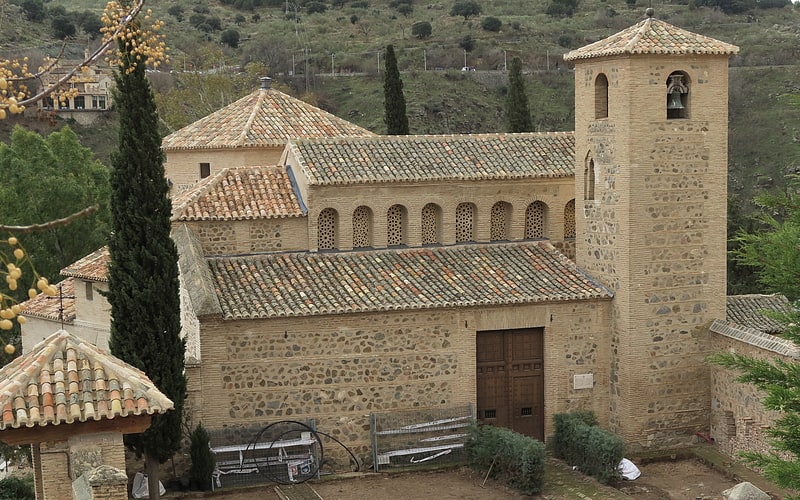
Also known as: Iglesia de San Lucas
Church in Toledo, Spain. The Church of San Lucas is located in front of the Bu hill at southeast of the city of Toledo, Castile-La Mancha, Spain. Behind a high wall, attached to the church, was located the old parish cemetery, where it is told that the last Mozarabs of the city were buried.
Most probably it was built in Mozarab style in the 12th-century, in the 17th century a Baroque chapel was added to it housing the Virgen de Esperanza.
The church is cited in a poem attributed to St. Ildefonsus, according to which it was erected in 641 by Evancio, a son of Nicholas, who married Blesila and who were the grandfathers of St. Ildefonsus. This documentary evidence cannot be confirmed and the building could even be a mosque adapted as a Christian church, due to the irregular arrangement of the south wall and the asymmetry of the immediate nave of the epistle.
The church served one of the parishes of Toledo that had the privilege to maintain the Mozarabic Rite after the Reconquista.[19]
Address: Plaza San Lucas, 5, 45001 Toledo
Church of San Miguel el Alto
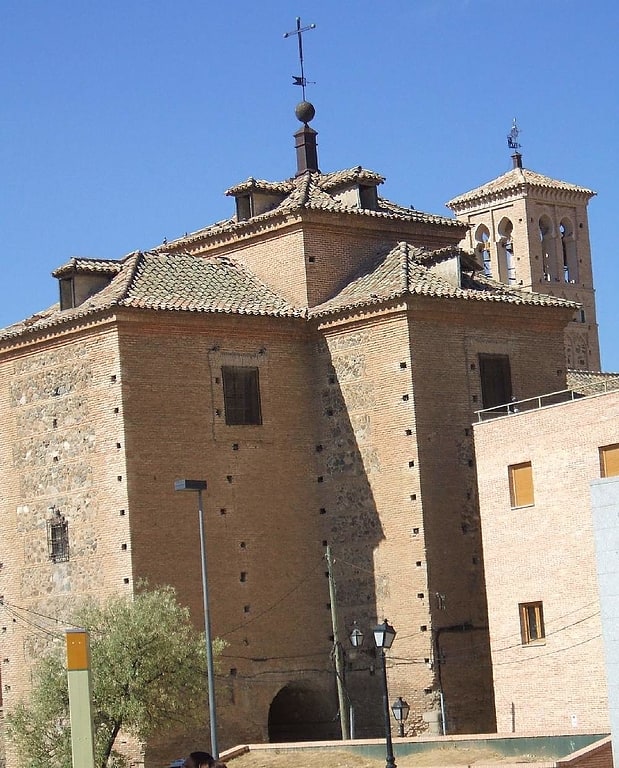
Also known as: Iglesia de San Miguel el Alto
The Iglesia de San Miguel el Alto is a building of medieval origin located in Toledo. Dedicated to St Michael, the church served one of the old Latin parishes of the city, but is now part of the parish of San Justo. It appears that it also had some relation to the Knights Templar who are believed to have had a guest-house in Toledo.
The original 12th century building was extensively remodelled in the 17th century by Juan Bautista Monegro, but retains some Mudejar features, notably its tower from around the end of the 13th century.[20]
Convento de San Clemente

Convent in Toledo, Spain. The Convento de San Clemente is a Renaissance convent located in the city of Toledo, in Castile-La Mancha, Spain. It was founded in the 13th century during the reign of Alfonso X of Castile the Wise. Inside the building there are a Roman cistern, Mudéjar architecture, remains of the Palacio de los Cervatos and many decorative elements.
It is a large building that contains a basements, a refectory, two cloisters, a chapter house, a church, a hallway, the nuns' choir, the portals, cisterns and other dependences.
It currently houses a museum dedicated to the marzipan that, according to a historic study and tradition, originated in this convent.[21]
Address: Plaza Padilla, 2, 45002 Toledo
Archbishop's Palace of Toledo
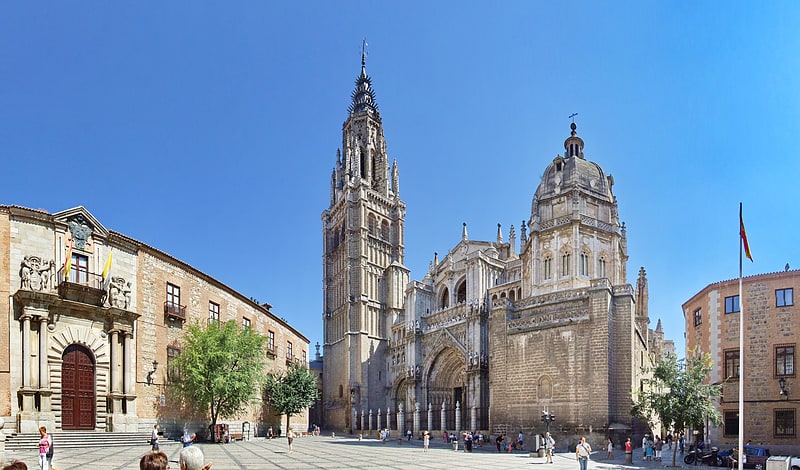
Also known as: Palacio arzobispal de Toledo
Tourist attraction in Toledo, Spain. The Palacio Arzobispal de Toledo or Archbishop's Palace of Toledo is a palace located in front of the Cathedral and next to the City Hall in the city of Toledo, region of Castile-La Mancha, Spain.
It was built on land donated to the church by Jose Manuel Thotocopuli, son of El Greco. The palace was constructed over centuries. Cardinal Tavera charged Alonso de Covarrubias with building an arch connecting to the cathedral as well as the main facade. In the 17th century a partial attempt was made to give uniformity to the facade.
Of interest are the portals, including the main one facing to the Plaza del Ayuntamiento. The flanking wings have composite brick and stone, but the center is smooth stone with a triangular tympanum. The small iron upper balcony is flanked with nymphs holding a cardinal's coat of arms. The tympanum is decorated with the Habsburg double eagle, decorated in Mannerist style with coupled columns.
The interior chapel was built in the Baroque style.[22]
Address: Calle Trinidad, 45002 Toledo
Church of Santiago
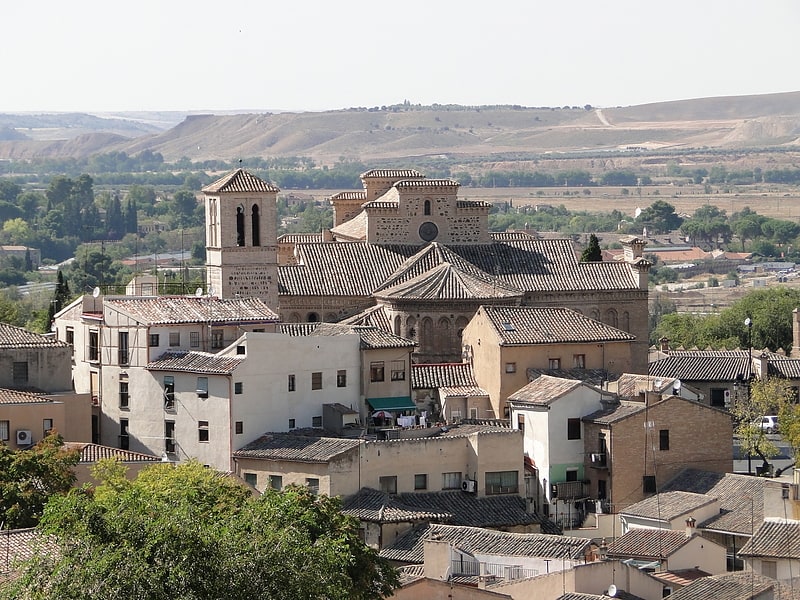
Also known as: Iglesia de Santiago del Arrabal
Building in Toledo, Spain. Santiago del Arrabal is a church in Toledo, Spain, built in 1245–48, at the orders of Sancho II, on the site of an earlier building, possibly a mosque. Many characteristics of Islamic architecture, such as the horseshoe arch, have remained in the present building which is built in the Mudéjar style.
The church is dedicated to Saint James ("Santiago" in Spanish), "del Arrabal" refers to its location on the outskirts of Toledo (Arrabal being a Spanish word of Arabic origin). The patrons of the church during its foundation were members of the Diosdado family, knight commanders of the Order of Santiago.[23]
Address: Plaza Santiag Arrabal, 4, 45003 Toledo
Iglesia del Salvador
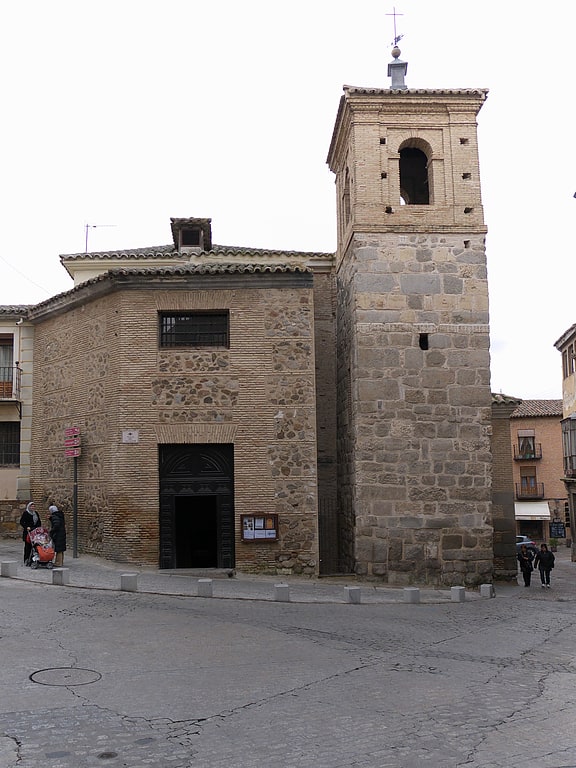
Also known as: Iglesia de El Salvador
Building in Toledo, Spain. The Iglesia de El Salvador is a church in Toledo, Spain completed in 1159.
Although the church is small, it is an exceptional building, because it was the site of 4 successive constructions, one on other and so on. It's a 12th-century church built on an 11th-century Taifa mosque, which was an expansion of a 9th-century Umayyad mosque and in turn on a Visigothic religious building.
The current church is still oriented south-east, in the direction of Mecca. It survived the conquest of Toledo by the Christian armies in 1085, to be turned into a church in 1159. One of the most characteristic elements of the church is a Visigothic pilaster, with intricate relief carvings.[24]
Address: Plaza Salvador S/N, 45002 Toledo
Alcázar of Toledo
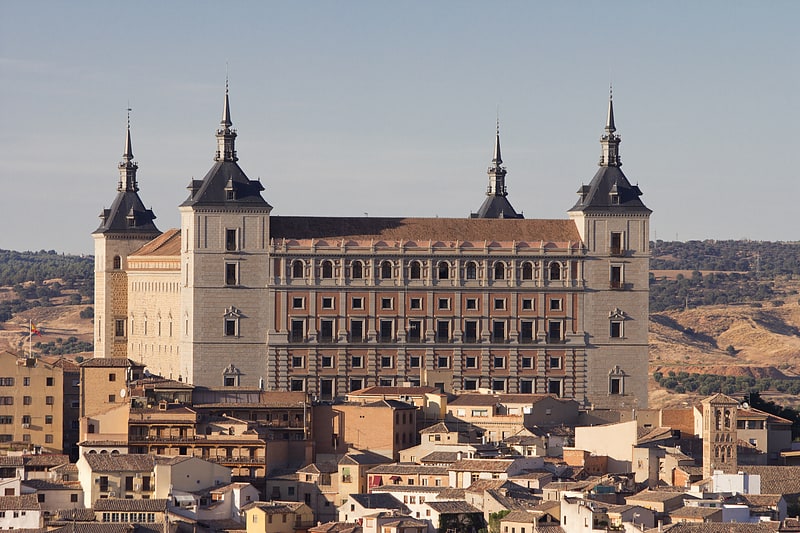
Also known as: Alcázar de Toledo
Fortification in Toledo, Spain. The Alcázar of Toledo is a stone fortification located in the highest part of Toledo, Spain. It is a large quadrangular building measuring 60 meters on a side, framed by four large towers 60 meters high, each crowned by the typical Madrid spire. Most of the city was rebuilt between 1939 and 1957 after the siege of the Alcázar during the Spanish Civil War.[25]
Address: Calle de la Union, s/n, 45001 Toledo
Teatro Rojas
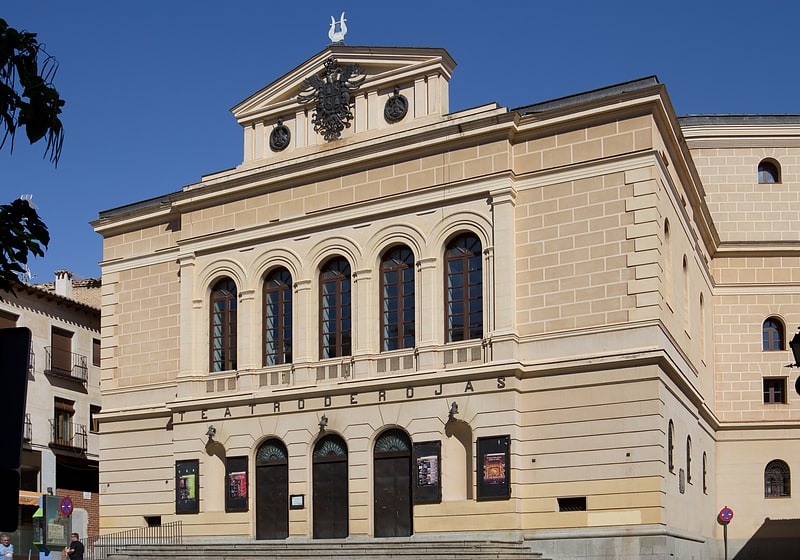
Also known as: Teatro de Rojas
Theater in Toledo, Spain. The Teatro Rojas is a theater in the city of Toledo. It was inaugurated in 1879 on the old corral de comedias called Mesón de la Fruta and in its construction participated several architects. It is denominated like this in honor of the Toledan playwright Francisco de Rojas.[26]
Address: Plaza Mayor, 45001 Toledo
Puerta del Sol
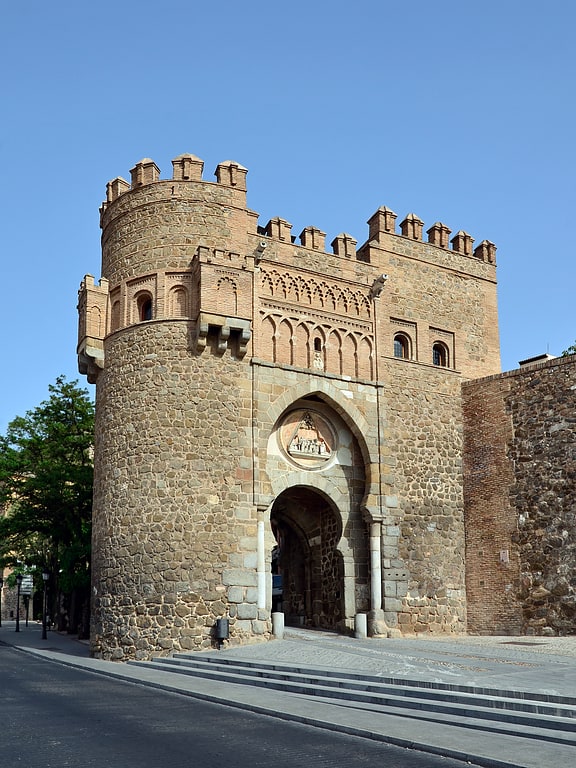
Historical landmark in Toledo, Spain. Puerta del Sol is a city gate of Toledo, Spain, built in the late 14th century by the Knights Hospitaller.
The medallion above the arch of the gate depicts the ordination of the Visigothic Ildephonsus, Toledo's patron saint. The name of the gate comes from the sun and the moon that were once painted on either side of this medallion.
This gate was named because of its orientation to the east, where the sun always rises. The gate is no longer there, but the entrance is.[27]
Address: Calle Carretas, Toledo
Convento de Santa Isabel de los Reyes

Convent in Toledo, Spain. The Convento de Santa Isabel de los Reyes is a convent located in the city of Toledo, in Castile-La Mancha, Spain. The current convent, founded in 1477 by Doña María Suárez de Toledo, known as "Sor María la Pobre", has its origins in two different palaces, both Mudéjar from the 14th century and the church of San Antolín.
It is accessed by the convent church, rebuilt during the reign of Charles V, Holy Roman Emperor, through a portal from the time of the Catholic Monarchs (1500). It is in Gothic style and is covered with wood-coffered ceiling.
The main altarpiece is dated in 1572, is Plateresque style and high reliefs. The choir of the nuns with a azulejos plinth, a Plateresque reredos and an ashlar, all of the 16th century, were all built at the base.
Part of the building is a museum.[28]
Address: Plaza Sta. Isabel, 0, 45002 Toledo
Church of Santo Tomé

Also known as: Iglesia de Santo Tomé
Mosque in Toledo, Spain. The Iglesia de Santo Tomé is a church located in the historical center of the city of Toledo, and was founded after the reconquest of this city by King Alfonso VI of León. It appears quoted in the 12th century, as constructed on the site of an old mosque of the 11th century. This mosque, together with other mosques in the city, were used as Christian churches without major changes, since in the taking of the city there was no destruction of buildings.
However, at the beginning of the 14th century, being in a ruinous state the church was totally rebuilt in charge of Gonzalo Ruiz de Toledo, Lord of Orgaz, and the old minaret of the mosque was transformed into a bell tower in Mudéjar style. Its fame is mainly due to the fact that it contains the painting The Burial of the Count of Orgaz by El Greco, which can be seen by accessing the back of church.[29]
Address: Plaza Conde 4, 45002 Toledo
Convento de Santa Fé

Also known as: Convento de Santa Fe
Convent of Santa Fe is a former monastery situated in Toledo, Spain. It is situated in the north-east of the historic centre of the city. Included in the heritage listing Bien de Interés Cultural, it has been protected since 30 September 1919.
It is built on ancient Muslim ruins.[30]
Address: Paseo Miradero, 3, 45001 Toledo
Puerta de Alarcones
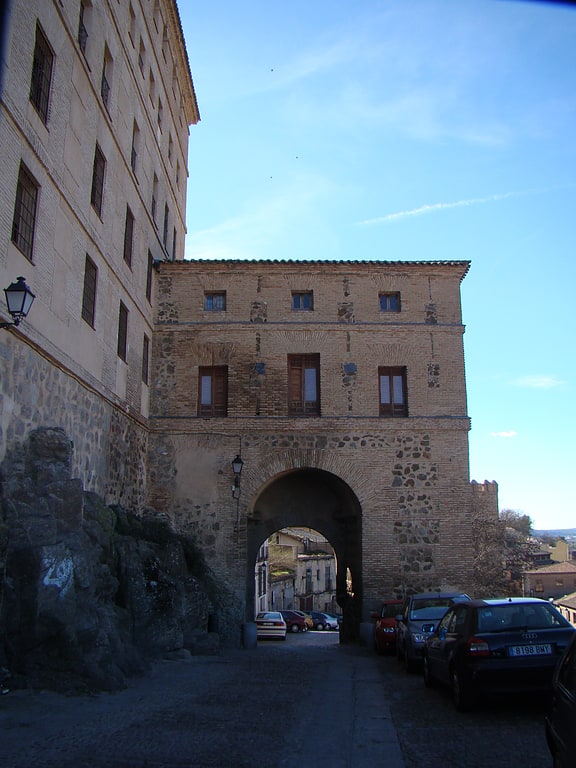
Historical landmark in Toledo, Spain. The Alarcones Gate is a city gate located in the city of Toledo, in Castile-La Mancha, Spain. It is also known by the name of Puerta de Moaguía, as cited in Mozarabic documents of 1216; and Puerta Alta de la Herrería, because it is located at the end of the street where workshops dedicated to ironworks were located.
The gate was the forced access to Zocodover square before opening the ascent of the street of the calle de las Armas, by the lookout, so that, along with the Puerta del Sol, it was adorned whenever Toledo was visited by some important personage, as a tribute to theirself to the passage of their cortege.
It is one of the oldest in the city, belonging to the Visigothic walled enclosure. The Puerta de Alarcones should have a also military crowning, which was destroyed, building itself.
A staircase has recently been discovered in its right-hand turret, whose gate existed earlier, deeper than this turret, which possibly gave access to the walls.[31]
Baños de Tenerías

The Baños de Tenerías were a public bath in Toledo, Castile-La Mancha. The structure has been dated to the beginning of the 11th century, when Toledo was under Islamic rule, and formed one of the six Arab baths in the city.
The Spanish name Tenerías refers to the baths being located in the leather-working district of the city. The baths would have offered the possibility of washing before prayers at the nearby Al-Dabbagin Mosque (which later became the Church of San Sebastián).
It is divided into the living room "bayt al-mash", the latrines, the cold room "bayt al-bárid", the temperate room "bayt al-wastani", the hot room "bayt al-sajûn", the cistern and the qanat.[32]
Church of San Andrés
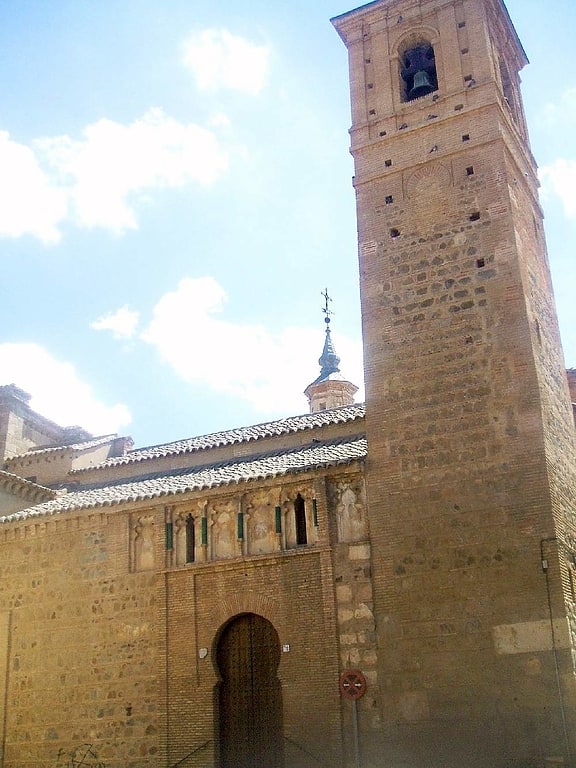
Also known as: Iglesia de San Andrés
Mosque in Toledo, Spain. The Church of San Andrés is a Catholic church located in the city of Toledo, in Castile-La Mancha, Spain. The building is of medieval origin, and as is common in this city, is a mix of different styles. It is protected by the heritage listing Bien de Interés Cultural.[33]
Convento de las Carmelitas Descalzas de San José
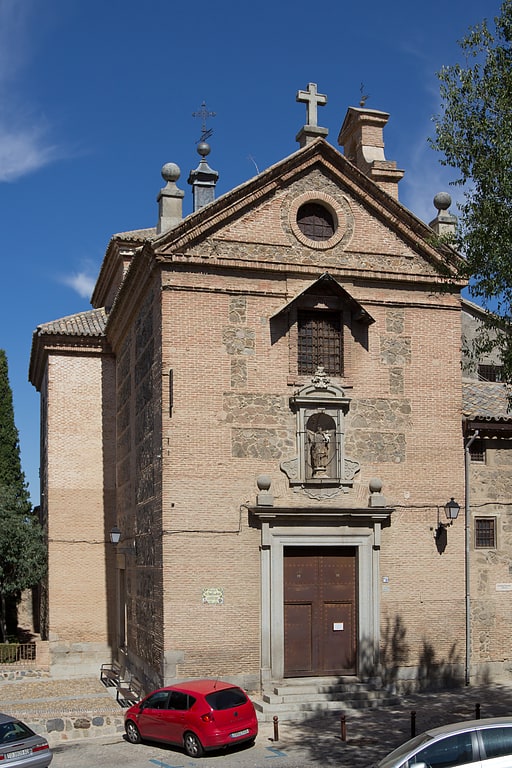
Also known as: Convento de las Carmelitas de San José
Building in Toledo, Spain. The Convento de las Carmelitas Descalzas de San José of Toledo is a monastic building dating from the second half of the 16th century.
The Toledan community of Discalced Carmelites was founded by St. Teresa of Ávila herself. Being the resting house of Saint Teresa in the city.[34]
Address: Plaza Sta. Teresa de Jesús, 2, 45002 Toledo
Palacio de Fuensalida
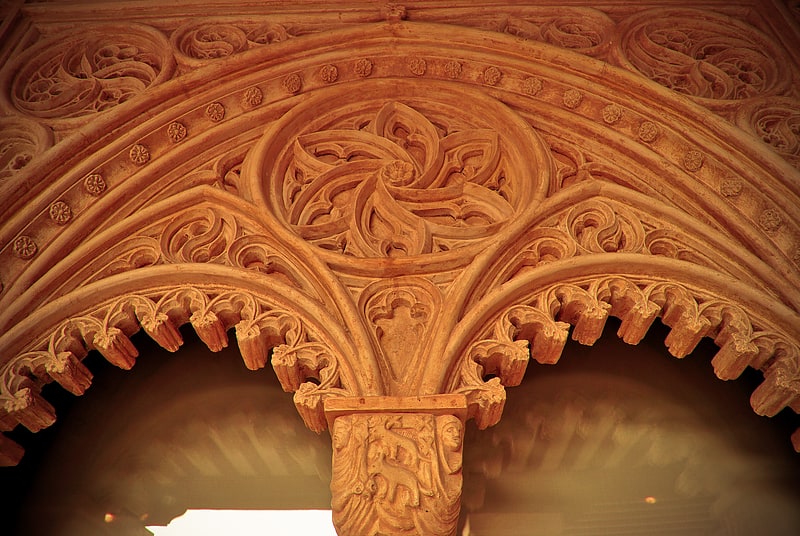
Palace in Toledo, Spain. The Palace of Fuensalida, is a palace located in city of Toledo built at the end of the first half of the 15th century by Pedro López de Ayala, the first lord of Fuensalida, is a great example of the Toledan Mudéjar, a historical typology that is scarce in Toledo built heritage, where merge three styles: Gothic, Plateresque and Mudéjar.
It is integrated in a big block, which also includes the Taller del Moro and the Iglesia de Santo Tomé, which forms the north façade of the Plaza del Conde.
The first Count of Fuensalida, Pedro López de Ayala, carved this house towards 1440 for the mayorazgos of this title, of which was founder. This first Count of Fuensalida, son of the famous Chancellor López de Ayala, was main mayor of Toledo, mayor of the fortresses of the city, and, consequently, retired mayor of the King.
Charles V, Holy Roman Emperor, despite his pilgrimage, landed in Toledo no less than nineteen homes, and he lived in this Palace while the construction of the Alcázar was completed. In his letters and in its courtyard, the child who would become king, Philip II, experienced some of his childhood experiences, along with his mother, the Empress. Today, a sculpture by Pompeo Leoni representing Isabel of Portugal presides over the courtyard of Fuensalida.[35]